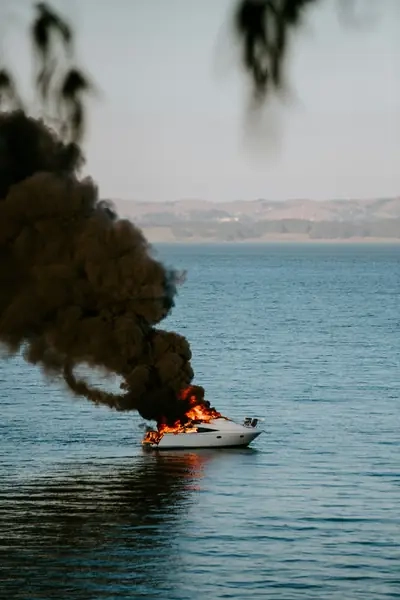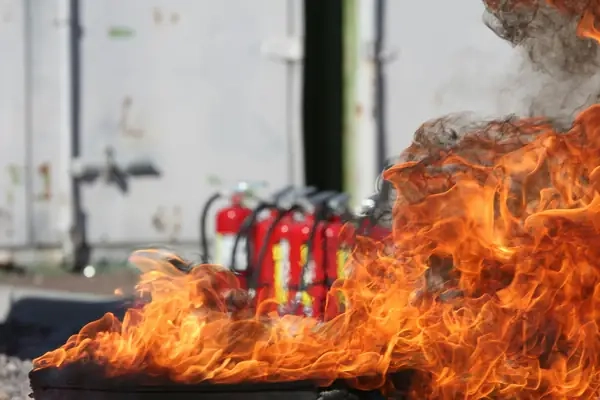Preventing and fighting fire aboard: the complete guide
A fire on board is one of the most feared scenarios for boaters. In a confined space, surrounded by flammable materials and multiple heat sources, a fire outbreak can quickly turn into a nightmare. No worries, though! With some planning and practical steps, you can turn the risk of fire into a manageable contingency. In this guide, we’ll go through the most important things you need to know to prepare for fires. We’ll go through the most effective gear. And we’ll also provide some useful tips to ensure the safety of your boat and its crew.

The main causes of fire on board a boat
Overheating electrical systems
A short circuit or overload can generate sparks. If the cables or equipment are in close proximity to flammable materials, these can catch fire. Worn or poorly insulated cables pose a significant threat, particularly in high humidity environments, where the risk of corrosion is heightened. By regularly inspecting and replacing any faulty equipment, you can prevent these situations from arising.
Prefer soldered or crimped terminals and lugs to strip connectors where screws can loosen due to vibrations. Use only flexible stranded wires (solid wires tend to micro-crack with vibration). Also be sure to use sheaths to protect cables. Compliant electrical installation and proper maintenance considerably reduce the risk of electrical fires.
Handling fuel
Gasoline or diesel fumes, combined with a spark or flame, can cause an explosion followed by fire. Some vapors, heavier than air, tend to settle in lower areas of the boat, such as the bilge. There, they become an invisible and lurking hazard. Before starting any engine, carefully ventilate areas where fuel is stored. Finally, when transferring fuel, it goes without saying that you should avoid any flames, cigarettes or heat sources nearby.
On-board cooking
Unsupervised stoves or ovens are a frequent cause of fire outbreaks. This particularly the case if flammable materials (towels, paper, plastic wrap) are nearby. A simple splash of oil on a flame can be enough to start a fire. It’s crucial to always keep an eye on cooking appliances when they’re in use. There should be a valve to cut off the cooking gas supply. As a precaution, it’s a good idea to turn it off immediately after use. Fit a fire blanket in the galley, and place it in an easily accessible place, away from sources of heat.
Flammable products
Improperly stored paints, solvents or cleaners can ignite easily. These products should be stored in airtight containers, away from heat sources and in well-ventilated areas. The vapors released by some solvents can also be toxic, hence the importance of proper storage. It’s also worth noting that some chemical reactions can get out of control because of the heat they generate. This is the case with epoxy, for example: it’s better to prepare several small batches than a single large one.

Classifying onboard fire hazards: a way to better firefighting
To prevent a fire, it’s important to understand the different types of fires. They’re generally categorized by the main cause of fire outbreak.
- Class A: Ordinary solid material (wood, cloth, paper)
- Class B: Flammable liquids (gasoline, diesel, oils)
- Class C: Electrical fires (short circuits)
Making the difference between these allows you to choose the right course of action and extinguishing equipment. For simplicity, though, most ABC fire extinguishers used on recreational boats aim to deal with all three classes of fires.
Recommended fire safety equipment
To ensure the safety of your boat, you need suitable firefighting equipment. Some of these recommendations are subject to regulatory requirements, depending on the navigation zone and/or flag of the boat.
Make sure each crew member knows where the fire extinguishers, fire blankets, and other safety devices are located and how to use them. Here are the essentials you need to know:
Fire extinguishers
Keep at least one ABC portable fire extinguisher per high-risk area (galley, cabin, engine room). Place extinguishers in strategic locations, including one in a cockpit locker in the event of a below-deck fire. Powder extinguishers are the most widely used, as they are the least expensive.
It’s worth noting, however, that powder causes significant and irreversible damage. It is very abrasive and becomes very corrosive in the presence of humidity. This means when used below deck, you will need to completely rebuild the interior of your boat. In particular, if powder is not completely and thoroughly removed, it can cause complete breakdowns several months after use. This is because it permanently attacks electrical installations, engines and electronic equipment.
CO₂ extinguishers are more pricey, and generally bulkier, but they can suppress an outbreak of fire without impacting materials. As such, they may be preferable.
A fixed fire-extinguishing system in the engine compartment may be mandatory for boats over a certain size or power. With its inert gas system, it provides an immediate response without the need to open the engine room.
All fire extinguishers require regular servicing and maintenance, every 1 to 3 years according to manufacturers’ recommendations and/or local regulations.
Smoke and gas detectors
Place smoke, gas or heat detectors away from drafts in areas at risk, such as the galley and engine room. They can detect a fire, overheating or a gas leak, saving precious time when responding to a fire. Test them regularly and make sure the batteries are in good condition. Setting a reminder in Ready4Sea is a great way to think about it! These simple devices greatly enhance safety on board, and can be complemented by a carbon monoxide detector for your own health.
Fire blanket
A fire blanket is an essential device for quickly putting out a localized outbreak, especially in the galley. Made from flame-retardant materials, it acts by cutting off the oxygen supply to the flames, without causing secondary damage like a fire extinguisher. Easy to use, compact and lightweight, it should be placed in an accessible place. It is a practical complement to fire extinguishers for added safety.
Water bucket
In the absence of any other solution, the classic bucket of water can be used to quickly extinguish a minor fire. If taking on large amounts of water, beware of the hull effect that could destabilize the boat.
VHF radio and distress beacon
We strongly recommend that you carry a VHF radio and an EPIRB (emergency beacon). The VHF(Very High Frequency) Radio wave frequency band, between 30 and 300 MHz. By extension, the most widespread marine radio sets, operating on a series of predetermined channels between 156 and 174 MHz, with a range of a few miles to a few dozens of miles. More radio can be used to quickly alert rescue services or nearby vessels in case of emergency. If you are out of VHF(Very High Frequency) Radio wave frequency band, between 30 and 300 MHz. By extension, the most widespread marine radio sets, operating on a series of predetermined channels between 156 and 174 MHz, with a range of a few miles to a few dozens of miles. More range, the beacon automatically transmits your GPS(Global Positioning System) Satellite positioning system with worldwide coverage, enabling users to determine not only their latitude and longitude, but also their heading and speed. More position to maritime authorities and rescuers. These means of communication can mobilize invaluable outside help.
Liferaft
Having a liferaft is the best solution in the event of an uncontrolled fire, as it is specially designed for emergency evacuation. If you don’t carry one, a dinghy can be a last-resort alternative, enabling the crew to leave the boat if the situation gets out of hand.

How to react effectively to a fire
If despite all due precautions a fire does break out, it is essential to act quickly and methodically:
Step 1: Recognize the type of fire
It can be difficult to precisely identify the type of fire, but its location provides valuable clues. In the engine room or galley, it’s likely to be a fuel-related fire (class B). In the electrical panel, it’s more likely to be a class C fire. Class A fires, involving solid materials such as wood or fabrics, are more likely to occur in living quarters, such as cabins or the saloon.
Step 2: Cut off fuels sources
Before attempting to act on the flames themselves, it’s essential to cut off the fuel supply. This will limit the spread of the fire. Start by stopping the engine and closing the fuel valves. Also, turn off the electrical power to avoid feeding an electrical fire and reduce the risk of short-circuiting.
Step 3: Use fire extinguishing equipment
If necessary, activate your fixed installation in the engine compartment. If you need to use a portable extinguisher, hold it firmly, aim at the base of the flames, and sweep horizontally. Note that a 1 kg extinguisher will last barely 30 seconds, so make it count!
To put out a fire using a fire blanket, lay it gently over the flames. Always put safety first, and proceed with caution.
Step 4: Evacuate if necessary
If the fire gets out of control, hand out lifejackets and prepare the crew to board the raft or dinghy. If you have prepared a grab bag or drum and it’s accessible, take it along. Ensure a quick and orderly evacuation.
Smooth sailing with controlled risks
By following these tips, not only can you prevent fires on board, but you can also considerably reduce its impact should one break out. A safe and well-maintained boat is one where you feel safe and secure. You will be ready to enjoy every trip out on the water.
When implementing fire prevention measures on board, the most difficult part is remembering to carry out regular checks. Ready4Sea, your maintenance assistant, will help you perform the key safety steps. It will remind you to maintain fire extinguishers, replace batteries, and check equipment such as lifejackets and liferafts. You’ll then be able to sail with complete peace of mind: your boat is ready to face any situation!
Subscribe to our monthly newsletter to receive tips on keeping your boat in good health.
